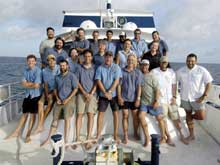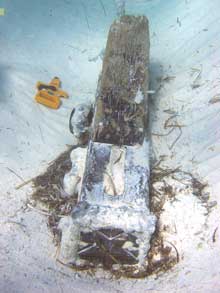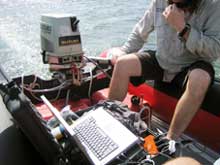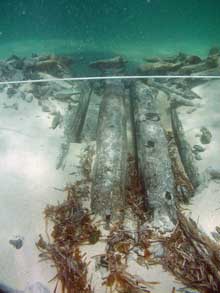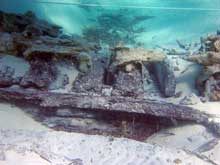
View of the Black Rock Wreck’s keel, garboard and frames from starboard side. A large sheet of copper sheathing studded with tacks lies in foreground. Click image for larger view and image credit.
Search for Trouvadore 2006 season team. Click image for larger view and image credit.
The Search for Trouvadore: Mission Summary
July 8 – July 22, 2006
Donald H. Keith, Ph.D.
Ships of Discovery
From July 8 through July 22, 2006, a team of explorers and researchers ventured out to sea aboard the Caribbean Explorer I to seek the final resting place of Trouvadore, a Spanish slaver that wrecked offshore of East Caicos island 165 years earlier, bringing the direct ancestors of some of today’s modern inhabitants to the islands.
The Story
In 1992, researchers from the Turks & Caicos National Museum working with microfilmed records in the Smithsonian Institution stumbled onto a manuscript inventory of artifacts collected by Mr. George Gibbs, a 19th-century resident of Grand Turk. The last entry in the inventory was cryptic:
Two African Idols found on board the last Spanish slaver (? “Esperanza”) wrecked in the year 1841 at Breezy Point Caicos.-The slaves were taken possession of by the Government and brought to the Grand Turk island-The Captain of the slaver, escaped the penalty, by being a Spaniard, of being hung according to British law.-The slaves were apprenticed for the space of one year and they and their descendants from at the present time, 1878 the pith of our labouring population.
The faint trail of official documents and informal correspondence discovered to date suggests that the event was well-documented at the time. The trail has led from the Smithsonian and the American Museum of Natural History, to the Turks and Caicos, to the Bahamas, Cuba, Spain, Portugal, and the island of Sao Tome. An effort is currently under way to locate these documents.
The bare bones of the story as we now know it, pieced together from available letters and depositions are as follows: A Spanish brigantine called Trouvadore (spelling varies) wrecked on 29 March 1841 near Breezy Point, East Caicos (George Gibbs’ reference to the wreck of a slave ship named Esperanza on East Caicos in 1841 is problematic: the date and place are right. We can only assume that in his letter written more than 30 years after the fact his memory was faulty and that is why he included a question mark before the name Experanza). Other records mention that a slave ship named Esperanza wrecked somewhere in the Caicos Islands in 1838, but all the Africans saved were sent to the Bahamas. The vessel appears to have been bound for Santiago, Cuba (“Saint Jajo de Cuba”), which may have been its home port.
All the crew and all the Africans except one survived. The survivors set up camp on shore and news of their plight soon reached the government on Grand Turk. Expeditions were dispatched to fetch the survivors back to Grand Turk--but this time it was the Spaniards who were in shackles, slavery having been outlawed in British possessions since 1834. Trouvadore’s Master and crew were eventually taken to Nassau and released to the custody of the Spanish Consul. The freed Africans were given food, clothing and medical attention, then indentured to various citizens for one year, which was thought to be sufficient time for their acculturation.
Because the people on board Trouvadore were the direct ancestors of many of the modern inhabitants of the Turks & Caicos Islands, this story is more than merely an interesting historical anecdote. As the significance of Trouvadore’s story emerged from the historical documents, the Director and Trustees of the Turks & Caicos National Museum agreed that a search for its remains was imperative.
The Search
The First Phase of the Search for Trouvadore project began in August 2004 with the arrival of a team of archaeologists assembled by the Museum and Ships of Discovery using the live aboard dive boat Turks and Caicos Explorer as a base of operations. In spite of losing almost half the charter time to hurricane Frances the team found the remains of a large wooden-hulled sailing ship near a prominence known as Black Rock. The Museum’s license from the government of the Turks and Caicos Islands permitted survey but not excavation, so no site testing was done at that time.
The Second Phase of the Search for Trouvadore began on July 8 and ended on July 22, 2006. Explorer Ventures, Ltd. supplied the same specially-equipped live-aboard dive boat (now named Caribbean Explorer I) used during the 2004 Search for Trouvadore project. Because the Museum’s license included permission to test excavate the small wooden wreck as well as to survey, the objectives of the 2006 phase of the Search for Trouvadore were: 1) to complete a magnetometer survey of the search area, 2) to complete the visual tow-board survey begun in 2004, 3) to test excavate the Black Rock Wreck discovered in 2004, and 4) to film every aspect of the project in high-definition video. All objectives of the project were met, in spite of rough seas throughout most of the charter.
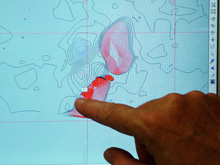
Test excavation proved that this large magnetic anomaly was caused by a deposit of iron fasteners and well-preserved ship’s timbers. Click image for larger view and image credit.
Magnetometer Survey
Realizing the limitations of the towboard visual survey conducted in 2004, a thorough magnetometer survey of the search area was a top priority. An unexpected problem encountered during our survey was the towed magnetometer sensor’s attractiveness to at least one barracuda that attacked it relentlessly, embedding two teeth in the instrument’s plastic housing! The magnetometer and positioning information we collected has not yet been fully processed, but several large anomalies were identified from the rough field data. One of these, lying to the East of the Black Rock wreck, was test excavated and proved to be a deposit of large, well-preserved timbers and iron and bronze fasteners thought to represent a “bounce spot” where the ship temporarily came to rest while breaking apart.
Tow Board Survey
A low-tech approach used to visually survey our search area included a towboard survey, where snorkelers are literally towed behind a small boat at a safe speed. The towboard survey, led by Museum Director Nigel Sadler, was highly successful despite rough seas that made the task more difficult and dangerous. Among the team’s accomplishments were the discovery that one suspected shipwreck site is really a “train wreck”– a place where a ship carrying railroad equipment was stranded and forced to jettison tons of railroad wheels and axles to escape the reef. The team also found the remains of a relatively modern sailboat in very shallow water at the extreme northwestern end of the survey area.
The decorated end of the cathead timber discovered at magnetometer anomaly T-1. Click image for larger view and image credit.
Test Excavations
Our team was relieved to find that the wreck site discovered in 2004 was undisturbed in the intervening two years.The first step to test excavating was to lay a reference baseline parallel to the keel and excavate sand at both ends of the wreck to determine the ship’s length. Within a few minutes of beginning test excavations we discovered that the site was larger, more deeply buried, and better preserved than previously believed. This effort was abandoned when we determined that one end of the keel was broken off, and the other end deeply buried under a thick bed of sand and turtle grass.
We moved and had more success test excavating “Test Pit 3.” At the new area our team was able to establish a minimum beam (width) of the ship, determine which structural timbers are and are not buried and preserved under the sand, and potentially identified the location of the mastercouple (widest frame in the ship). The test pit also revealed an intriguing construction feature: the ship’s framing pattern alternates full floor timbers running all the way across the keel with half-frames that terminate on top of the keel.
Samples were taken from each different type of structural timber encountered for species identification. If one or more exotic species were used in the construction of the ship they may provide a clue to where the ship was built. A small number of artifacts were collected in the hope that they too might shed light on the ship’s identity. Although these are presently being analyzed, none of them appears to be particularly diagnostic.
Photographic and Video Documentation
Under the direction of Windward Media, all aspects of the project on the surface and below water were filmed in high-definition video. Windward is partnering with the PBS television station KUHT of Houston to produce a television documentary of the Search for Trouvadore. In addition to the Museum’s Web site devoted to the Trouvadore story, www.slaveshiptrouvadore.com ![]() , Windward Media designed a site to go with the documentary film, www.trouvadore.org
, Windward Media designed a site to go with the documentary film, www.trouvadore.org ![]() . The Museum’s website includes a daily blog while the documentary film website focuses on mission updates as milestones were reached.
. The Museum’s website includes a daily blog while the documentary film website focuses on mission updates as milestones were reached.
Results
The results of the Search for Trouvadore Project are now part of the Turks & Caicos National Museum’s ![]() inventory of sites of historical and archaeological significance. This information is a valuable asset that will always be available to the Department of Environment and Coastal Resources and other authorized government entities. Perhaps as significant, the project has set precedents in the Turks and Caicos Islands for how licenses for archaeological surveys and excavations should be drawn up, what requirements for reporting should exist, what should happen to the artifacts recovered, and how the results should be disseminated.
inventory of sites of historical and archaeological significance. This information is a valuable asset that will always be available to the Department of Environment and Coastal Resources and other authorized government entities. Perhaps as significant, the project has set precedents in the Turks and Caicos Islands for how licenses for archaeological surveys and excavations should be drawn up, what requirements for reporting should exist, what should happen to the artifacts recovered, and how the results should be disseminated.
Related Links
Ships of Exploration and Discovery Research

Turks & Caicos National Museum

Sign up for the Ocean Explorer E-mail Update List.






